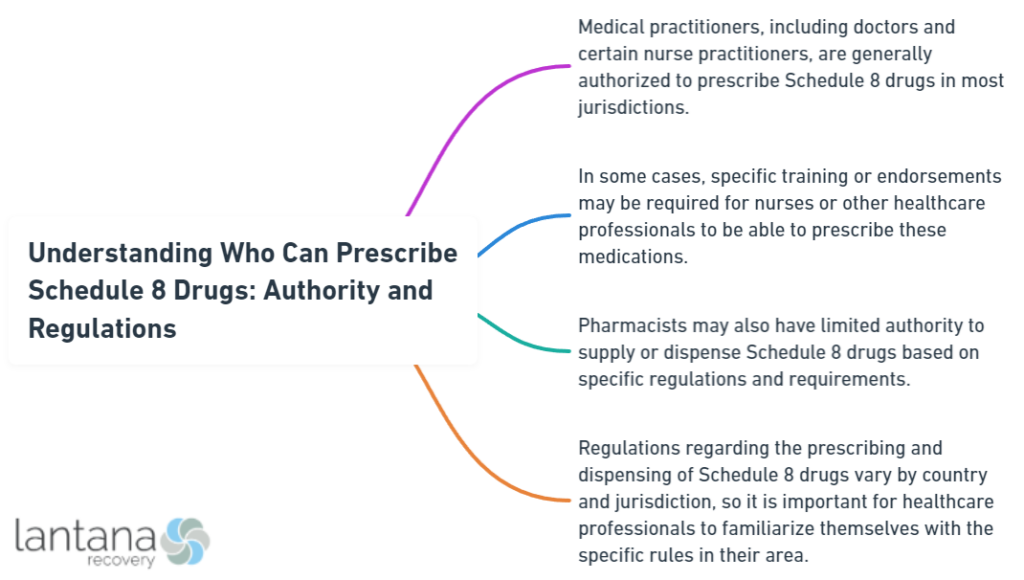You’re searching for who can prescribe Schedule 8 drugs, and we have the answers. In this article, we’ll guide you through the specific authorities granted to physicians, nurse practitioners, and physician assistants, detailing the regulations that dictate their prescribing rights. From stringent authorization procedures to state-by-state variations, gain a clear understanding of who holds the power to prescribe these highly regulated medications.
Key Takeaways
- Schedule 8 drugs have therapeutic value but a high potential for misuse, requiring careful regulation and control in their prescription and dispensing.
- Authorized healthcare providers like physicians, nurse practitioners, and physician assistants have varying degrees of prescriptive authority for Schedule 8 drugs, which is governed by complex state and federal laws.
- Pharmacists play a critical role in ensuring the safe dispensing of Schedule 8 drugs through diligent verification, record-keeping, and vigilance against misuse and abuse.
Schedule 8 Drugs: An Overview

Schedule 8 drugs, also known as schedule 8 medicines or drugs of addiction, are a category of medications that, while indispensable in the medical arsenal, carry an inherent risk of abuse and dependence. These substances strike a fine balance between therapeutic necessity and the potential for misuse, necessitating stringent management and oversight. Some examples of Schedule 8 drugs include:
- Morphine
- Oxycodone
- Methadone
- Fentanyl
- Amphetamines
It is important to handle these drugs with care and follow all regulations and guidelines to ensure their safe and appropriate use.
The gravity of addiction and the dire consequences of misuse underscore the need for a robust framework of control measures to safeguard public health. Recognized as controlled substances, Schedule 8 drugs require careful scrutiny to prevent the occurrence of substance use disorders.
Examples of Schedule 8 Drugs
Consider the formidable opioids like fentanyl, oxycodone, and morphine, which stand as mainstays in the realm of pain management, yet lurk as Schedule 8 drugs due to their high potential for dependency. Benzodiazepines, prescribed for their calming effects in anxiety and sleep disorders, also fall into this category, with alprazolam serving as a prime example.
The list extends to certain stimulants such as methylphenidate and lisdexamfetamine, which, despite their therapeutic role in ADHD, are controlled due to the risk of abuse.

Schedule 8 Drug Regulations
The labyrinth of regulations that govern the prescription and supply of Schedule 8 drugs is designed to prevent misuse and diversion, ensuring these potent medications are used in a manner that is both safe and effective. Healthcare providers face the task of:
- Acquiring appropriate authorization
- Abiding by set quantity limits
- Navigating through each Australian state’s unique set of forms and approval processes.
Pharmacists, too, must toe the line, ensuring the lawful sale and supply of these substances, fulfilling all legal prerequisites before dispensing. The regulations can vary, as illustrated by the New South Wales policy, which does not require an authority to prescribe a drug of addiction to a hospital inpatient for stays under 14 consecutive days, showcasing the nuances that exist within state-specific exceptions.
Alcohol Rehab South Carolina
If you or a loved one are struggling with alcohol addiction in South Carolina, seeking professional help from reputable alcohol rehab centers can be crucial for recovery. South Carolina offers various treatment facilities and programs tailored to address alcohol addiction effectively. These rehab centers typically provide a range of services, including detoxification, counseling, therapy, and aftercare support. Choosing the right alcohol rehab program in South Carolina involves considering factors such as location, treatment approach, amenities, and success rates. Additionally, it’s essential to verify whether the facility is accredited and staffed by licensed professionals to ensure quality care and successful outcomes. Taking the step to enter alcohol rehab in South Carolina can be the first vital move towards a healthier, sober life.
Prescribing Authority for Schedule 8 Drugs

Navigating the prescriptive authority for Schedule 8 drugs can be akin to deciphering a complex code, with different healthcare providers vested with varying degrees of power to prescribe these controlled substances. Here is a breakdown of the prescriptive hierarchy for Schedule 8 drugs:
- Physicians: They wield the most significant authority and can often prescribe Schedule 8 drugs without individual authorization, as long as they follow the established guidelines.
- Nurse Practitioners: They have their own space within the prescriptive hierarchy and can prescribe Schedule 8 drugs, but their authority may be more limited compared to physicians.
- Physician Assistants: They also have their own space within the prescriptive hierarchy and can prescribe Schedule 8 drugs, but their authority may be more limited compared to physicians and nurse practitioners.
It is important to note that the prescriptive authority for Schedule 8 drugs may vary depending on legislation and the evolving roles of other prescribers in healthcare.
As the gatekeepers of these potent medicines, providers are under the watchful eye of regulatory bodies, including the Therapeutic Goods Administration, ensuring compliance and minimizing the risks of misuse and diversion.
Medical Practitioners
Medical practitioners, before they can wield the pen that prescribes Schedule 8 drugs, must secure authority from bodies such as the NSW Ministry of Health. The process involves a dance of paperwork, with authority forms meticulously completed and sent to the Pharmaceutical Services Unit, either electronically or via fax, as part of the pharmaceutical benefits scheme.
The regulations afford some leniency, as in the case for hospital inpatients, where an authority is not mandatory for prescriptions unless the admission extends beyond a fortnight.
Nurse Practitioners
Nurse practitioners, the versatile chameleons of the healthcare system, have earned the authority to prescribe Schedule 8 drugs across the vast American landscape since 2010. Their prescriptive power, however, is not uniform, varying from:
- Full practice authority in twenty-two states, prescribing medications akin to their physician counterparts
- Reduced authority in some states, requiring collaborative agreements with physicians
- More stringent restrictions in other states, necessitating physician supervision.
Some states, like Georgia and West Virginia, place firmer limits on their ability to prescribe Schedule II medications, while in Arkansas and Missouri, the prescription of hydrocodone combinations is specifically curtailed.
Physician Assistants
Physician Assistants (PAs) occupy a unique position in the prescriptive order, with their authority to prescribe Schedule 8 drugs stemming from the supervision of a physician and the intricate web of state or territory legislation. The scope of a PA’s prescribing power is often outlined within a practice agreement, and some states also mandate registration with the state medical board and the DEA.
In countries like Australia, regulations regarding PAs, Schedule 8 drugs, and Medicare Australia are still maturing, reflecting the profession’s evolving status within the healthcare landscape.
The Role of Pharmacists

Pharmacists, the sentinels of medication safety, play a pivotal role in the dispensing of Schedule 8 drugs, tasked with the meticulous verification of prescriptions. Their role extends beyond the counter, as they vigilantly monitor for signs of misuse or abuse, embodying a crucial component in the safeguarding process.
Dispensing Schedule 8 Drugs
In the act of dispensing Schedule 8 drugs, pharmacists are the final checkpoint, ensuring that prescriptions are legitimate and in strict adherence to the letter of the law. This diligence extends to:
- A thorough check that patient details and drug quantities are meticulously recorded on the prescription
- Ensuring that drugs are labeled accurately before they reach the hands of patients
- Transitioning the original prescription from patient to pharmacist to the appropriate regulatory body, as exemplified by the Drugs of Dependence Unit, securing the chain of accountability.
Monitoring Drug Usage
Pharmacists, in their role as gatekeepers, have several responsibilities when it comes to Schedule 8 drugs. These include:
- Maintaining meticulous records of all Schedule 8 drug transactions
- Documenting each transaction in a drug of dependence register for a minimum of two years
- Spotting drug-seeking behaviors and taking steps to prevent dependence and illicit trafficking
- Safely disposing of medications, ensuring they are rendered unusable
- Having the disposal witnessed and recorded to complete the circle of care.
These responsibilities help ensure the safe and responsible use of Schedule 8 drugs.
Support from entities like the Drugs of Dependence Unit bolsters pharmacists in their multifaceted responsibilities, from monitoring to implementing safeguards.
What Are Benzodiazepines
“What are benzodiazepines” is a fundamental question in the realm of psychopharmacology. Benzodiazepines are a class of psychoactive drugs that exert their effects by enhancing the activity of gamma-aminobutyric acid (GABA) in the brain. GABA is a neurotransmitter that inhibits brain activity, leading to a calming or sedative effect. These medications are commonly prescribed to treat anxiety disorders, insomnia, muscle spasms, and seizures due to their anxiolytic, sedative-hypnotic, muscle relaxant, and anticonvulsant properties. Examples of benzodiazepines include diazepam (Valium), alprazolam (Xanax), and lorazepam (Ativan). However, they are also associated with potential risks, including tolerance, dependence, and withdrawal symptoms, especially with long-term use or misuse. Therefore, their prescription and use require careful consideration and monitoring by healthcare professionals.
Safeguards and Monitoring Systems

In the realm of Schedule 8 drugs, a fortress of safeguards stands guard, with secure storage facilities such as safes and vaults ensuring that unauthorized hands are kept at bay. These systems, including Prescription Drug Monitoring Programs (PDMPs) and Risk Evaluation and Mitigation Strategies (REMS), form the bulwark against the misuse of these potent substances.
Prescription Drug Monitoring Programs (PDMPs)
PDMPs serve as the watchful eyes over controlled substance prescriptions, casting a net wide enough to catch patterns of misuse, pinpoint at-risk patients, and flag irregular prescriber behaviors. These programs exist in various forms, from non-mandated to proactive reporting to mandated use, the latter of which has demonstrated a notable impact on curtailing opioid prescriptions and the decline of doctor shopping.
Healthcare providers, armed with access to PDMP data, wield the power to generate reports that range from individual patient histories to broader analyses of prescription trends, offering a critical tool for epidemiologic surveillance.
Risk Evaluation and Mitigation Strategies (REMS)
Risk Evaluation and Mitigation Strategies (REMS) programs take a targeted approach, honing in on specific serious risks associated with certain medications. By focusing on mitigating particular serious risks, rather than all adverse events, REMS ensure that the most severe potential outcomes of drug use are attentively managed. These programs are not just about informing but are designed to educate and reinforce behaviors that diminish the frequency and severity of serious events, as exemplified by the REMS program for Zyprexa Relprevv, which necessitates post-administration observation in certified healthcare facilities.
Special Considerations for Prescribing Schedule 8 Drugs

When it comes to prescribing Schedule 8 drugs, certain scenarios demand a higher level of scrutiny and tailored approaches. Both drug-dependent patients and those with a medical condition requiring palliative care or cancer pain management present unique challenges that call for specialized consideration.
Drug-Dependent Patients
Treating drug-dependent patients, including those identified as a drug dependent person, with Schedule 8 drugs is akin to navigating a minefield, requiring a vigilant monitoring system and a well-thought-out treatment plan that includes strategies for tapering and withdrawal symptom management. In Australia, for example, practitioners must obtain additional authorization from the state health department for prescribing to drug-dependent individuals or for treatments exceeding two months.
It’s imperative for providers to:
- Strike a delicate balance, weighing the benefits against the risks of exacerbating dependency
- Educate themselves on opioid use disorder to distinguish between dependency and misuse
- Ensure that opioid analgesics are prescribed appropriately
This will help to ensure that patients receive the necessary pain relief while minimizing the risk of addiction and misuse.
Palliative Care and Cancer Pain Management
In the tender landscape of palliative care and cancer pain management, opioids often take center stage, ensuring adequate pain control as patients near the end of life. Prescribers must navigate specific guidelines and exemptions tailored to these settings, all with the goal of facilitating optimal pain management. The approach to medication in these settings is characterized by a shift from oral to subcutaneous routes and a focus on deprescribing drugs aimed at long-term health in favor of those that provide immediate symptomatic control.
Such polypharmacy reduction and deprescribing initiatives are integral to the improvement of hospital palliative care support teams, underscoring the primacy of comfort and symptom management in the end-of-life journey.
Who Can Prescribe Medication
In the realm of healthcare, the question of who can prescribe medication is vital for ensuring safe and effective treatment. Generally, licensed healthcare professionals such as physicians, nurse practitioners, and physician assistants hold the authority to prescribe medication. These professionals undergo rigorous training and education to gain the necessary knowledge and skills to make informed prescribing decisions. However, the specific regulations governing prescribing authority vary depending on factors such as jurisdiction and the type of medication involved. Pharmacists also play a crucial role in medication management, although their role primarily involves dispensing medications rather than prescribing them. Additionally, advancements in telemedicine have expanded access to prescription services, with some states allowing certain healthcare providers to prescribe medications via online consultations. Overall, understanding the qualifications and limitations of those who can prescribe medication is essential for ensuring patient safety and optimal healthcare delivery.
Legal and Ethical Responsibilities of Prescribers
Prescribers of Schedule 8 drugs, including multiple prescribers, shoulder a heavy burden of legal and ethical responsibilities, such as:
- Obtaining permits
- Ensuring that every prescription is rooted in clinical need and free of outside influence
- Meticulous adherence to both federal and state laws
- Strict regulations that dictate dosage limitations and repeat prescription restrictions
These measures form a comprehensive framework to prevent abuse and diversion of these drugs.
State Legislation and Compliance
State legislation plays a pivotal role in determining the prescription practices of Schedule 8 drugs, categorizing substances based on their medical utility and potential for abuse. Physicians, equipped with a DEA license, are authorized to prescribe these drugs, while patients are expected to comply with the legal aspects of their treatment. In this realm, understanding and adherence to the law are not just recommended; they are imperative.
Addressing Misuse and Over-Prescription
The fight against misuse and over-prescription of Schedule 8 drugs is a multifaceted one, involving comprehensive patient assessment, strategic treatment planning, and vigilant monitoring. Healthcare providers must be adept at recognizing drug-seeking behaviors and equipped with the knowledge to distinguish authentic pain management needs from potential misuse.
Through education and adherence to federal guidelines, providers can expand treatment options for opioid use disorder and ensure safe opioid prescribing practices that balance pain control with the minimization of dependency risks.
Summary
As we close the chapter on Schedule 8 drugs, it becomes clear that the journey from prescription to dispensing is a path fraught with responsibility. The thoughtful orchestration of regulations, safeguards, and monitoring systems underscores a deep commitment to patient safety and public health. It is the collective effort of medical practitioners, nurse practitioners, physician assistants, and pharmacists, all bound by legal and ethical codes, that ensures these powerful drugs serve their intended purpose without falling prey to misuse. May the insights from this exploration resonate with the gravity and care with which these medications must be handled.
Frequently Asked Questions
Which of the following professionals has the authority to prescribe medication and treatment?
Nurse practitioners, physicians (MDs and DOs), physician assistants, and a few other health professionals have the authority to prescribe medication and treatment. This includes controlled substances, making them key figures in providing essential medical care.
Who can prescribe Schedule 8 drugs NSW?
In NSW, authorized practitioners who can prescribe Schedule 8 drugs include medical practitioners, nurse practitioners, midwife practitioners, and dentists. Additionally, from 13 November 2023, psychiatrists, paediatricians, and neurologists will also be authorized to prescribe Schedule 8 psychostimulant medicines under a class authority issued by the Ministry of Health.
Can a GP prescribe benzodiazepines?
Yes, a general practitioner can prescribe benzodiazepines for conditions such as anxiety, insomnia, and seizures.
What are Schedule 8 drugs and why are they important?
Schedule 8 drugs, also known as drugs of addiction, are important because they provide therapeutic benefits for conditions like severe pain, anxiety, and ADHD, but must be carefully managed due to their high potential for abuse and dependence.
What role do pharmacists play in the use of Schedule 8 drugs?
Pharmacists play a crucial role in verifying, dispensing, and monitoring Schedule 8 drugs to prevent misuse or abuse, and they also ensure safe disposal of these medications.








